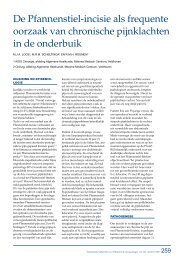Surgical management of chronic inguinal pain syndromes - Liespijn
Surgical management of chronic inguinal pain syndromes - Liespijn
Surgical management of chronic inguinal pain syndromes - Liespijn
Create successful ePaper yourself
Turn your PDF publications into a flip-book with our unique Google optimized e-Paper software.
period, a 25% reduction on their income is applied, leaving €25.000 (75% <strong>of</strong> €34000). Thestate will take over from this time period and compensate the beneficiary. Over a 10-yearperiod the average total costs will approximate €29.000 per year.Yearly, 2% <strong>of</strong> the postherniorrhaphy hernia repairs will result in severe <strong>pain</strong>. In theNetherlands, some 440 <strong>inguinal</strong> hernia repair patients (2% <strong>of</strong> 22.000 <strong>inguinal</strong> herniarepairs) will eventually develop a <strong>chronic</strong> <strong>pain</strong> syndrome. Most <strong>of</strong> these patients willsuffer from neuropathic <strong>pain</strong> that is treatable by a neurectomy. The questionnaire thatPatients with <strong>chronic</strong>postherniorrhaphy groin<strong>pain</strong> who received tailoredneurectomywas used to study our neurectomy patients showed that half <strong>of</strong> the population wasexcluded from further analysis because <strong>of</strong> studentship, retirement, pre-operative occupationaldisability, or unemployment. If these percentages were used in the entire Dutchpopulation, some 220 patients with severe <strong>pain</strong> are unable to return to their workyearly. Our results show that about half <strong>of</strong> these patients (n=110) have become occupationallydisabled after their <strong>inguinal</strong> hernia repair (220/ 2= 110). The total yearly costsfor workers’ compensation in The Netherlands will thus amount to 110 x €29.000 = €3.2million. Without treatment these costs will accumulate every year. In contrast, the costsfor operative neurectomy are only €1300 per person. As previously mentioned, aneurectomy can reduce occupational disability with more than 50%. Thus €1.6 million(50% <strong>of</strong> €3.2 million) can be saved in The Netherlands per year if all patients on workers’compensation due to severe postherniorrhaphy <strong>pain</strong> were treated with a neurectomy.Occupational disabilitydue to postherniorrhaphy<strong>pain</strong> (total n=13:partial n=7, complete n=6)Contacted by telephone(n=48)Response rate 89%No occupational disabilityprior to groin hernia repair(n=28)Excluded (n=20)- Retired (n=7)- Student (n=3)- Pre-operativedisability due toother reasons (n=10)No occupationaldisability due topostherniorrhaphy<strong>pain</strong> (n=15)DISCUSSIONPain-induced occupational disability after routine <strong>inguinal</strong> hernia repair should be considereddisastrous. This complication probably affects half <strong>of</strong> the patients with severepostherniorrhaphy groin <strong>pain</strong> (some 1% <strong>of</strong> all operated patients) 1-3 . Adequate treatment<strong>of</strong> these <strong>pain</strong> <strong>syndromes</strong> is vital for the patient’s physical and mental health status.Considering only a few studies report on the effect <strong>of</strong> neurectomy on occupationaldisability 13,15,16,28 , some 56 to 100% <strong>of</strong> the neurectomized patients were again able torejoin the working process. Moreover, there is no report on patients becoming moredisabled after a neurectomy. However, it should be realized that the data were <strong>of</strong>tenincomplete and inconsistent. It is obvious that the current body <strong>of</strong> literature on theTreatment costsOperative neurectomy € 1.300(Including operative costs, hospital admission, visits at outpatient clinic)Occupationaldisabilitydissolved afterneurectomy(total n=7:same work n=6,other work n=1Occupationaldisability didnot dissolve afterneurectomy(total n=6:partial n=2,complete n=4)No occupationaldisability afterneurectomy(n=15)Occupationaldisability afterneurectomy(n=0)Workers’ compensation (per year)Average salary over 10 years € 27.000Additional costs € 2.000(replacement, loss <strong>of</strong> productivity)Cost-effectiveness <strong>of</strong> successful neurectomy€ 27.700 (first year)in a patient on workers’ compensation€ 29.000 (following year)Figure 1 Flow chart <strong>of</strong> occupational disability in patients receiving neurectomy for <strong>chronic</strong> postherniorrhaphy groin <strong>pain</strong>.Table 3 Cost-benefit analysis.130 Chapter 9Occupational disability due to <strong>chronic</strong> postherniorrhaphy neuralgia: a plea for tailored neurectomy 131





